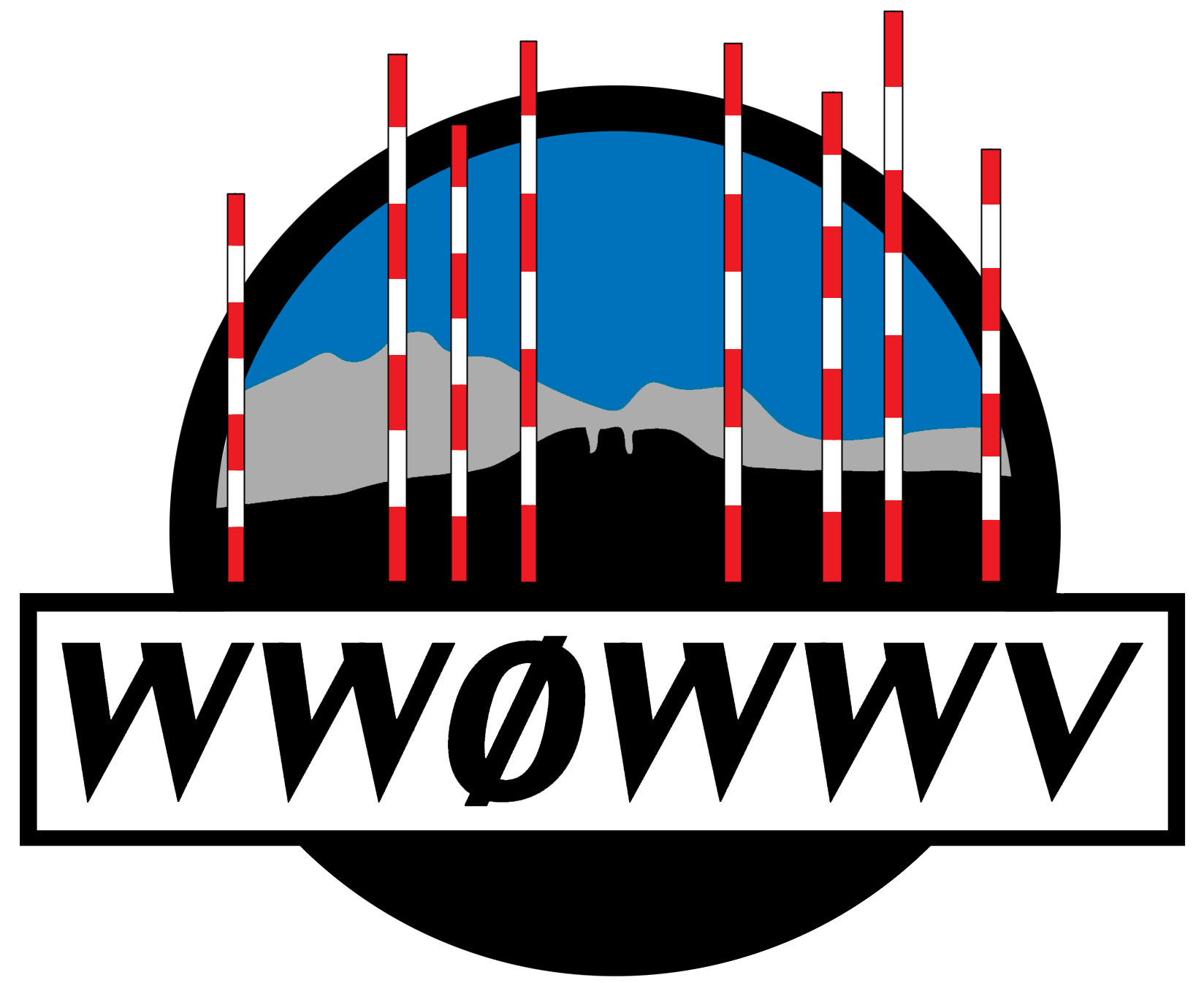last updated September 21, 2021
The WWV 100th Anniversary - October 1, 2019
The WWV 100th Anniversary in October 2019 was the result of a successful collaboration between amateur radio operators from across the country and the staff at NIST radio station WWV in Fort Collins, CO, and the NIST labs in Boulder, CO and Gaithersburg, MD.
The idea for a celebration of the 100th anniversary was suggested by Douglas Sutton, Field Technician at WWV, while giving a tour to a northern Colorado IEEE chapter in October 2018. Dave Swartz, WØDAS, happened to be on that tour, and a life-long “fan” of WWV and the NIST Time and Frequency services. Dave shared the idea of hosting a celebratory Amateur Special Event Station (SES) with the Northern Colorado Amateur Radio Club (NCARC) in November 2018 and the board agreed to pursue the event.
Kevin Utter, N7GES, had arranged for tours for NCARC in the past, and contacted Matt Deutch, NØRGT, Chief Engineer, about the possibility of a SES, and the WWV 100th Committee met for the first time at the beginning of December 2018 to float the idea. Committee members also included Darren Kalmbach, KCØZIE, and James Cizek, KIØKN. The whole WWV NIST staff was very supportive, and Matt carried the idea up the ladder to his superior, Station Manager John Howe.
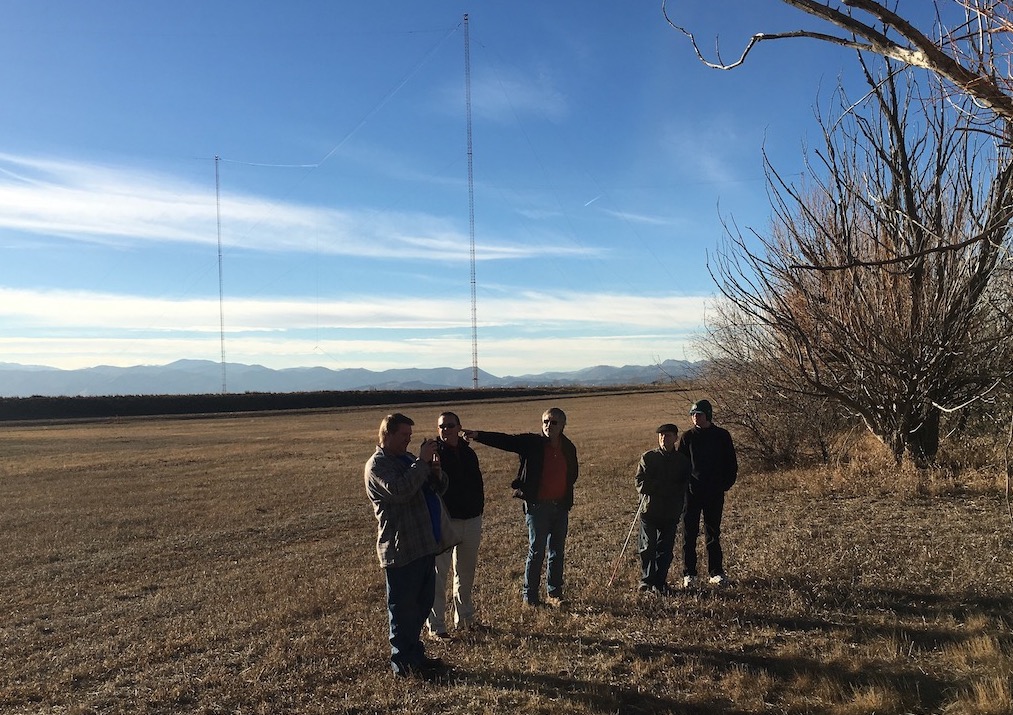
No sooner had the planning begun, the US Government was forced to shut down for the longest recorded stretch in history, and it took another month after re-opening for many agencies to get fully running.
The WWV 100th Committee decided to form the WWV ARC as a rallying group for the many different hams and amateur clubs that would come together to produce the SES, and the call sign WWØWWV was assigned to the new club in February 2018.
At a March meeting following the government re-opening, WWV, WWVB, WWVH Station Manager John Howe discussed the need for an MOU and had NIST officials prepare the document. Joining the committee in March were Mark Holbrook, WS7M and Eric Tamme, KKØECT. The Committee reached out to two major manufacturer’s, Flex Radio and Elecraft, and secured equipment loans for the event.
Applications for the event were opened in March, and the event was announced via QRZ and also through the ARRL Letter. Dave travelled to Dayton for Hamvention 2019 along with Matt from WWV to promote the event with the assistance of US Army MARS and Col. Paul English (ret), WD8DBY. Dave also secured antenna loans from SteppIR while in Dayton.
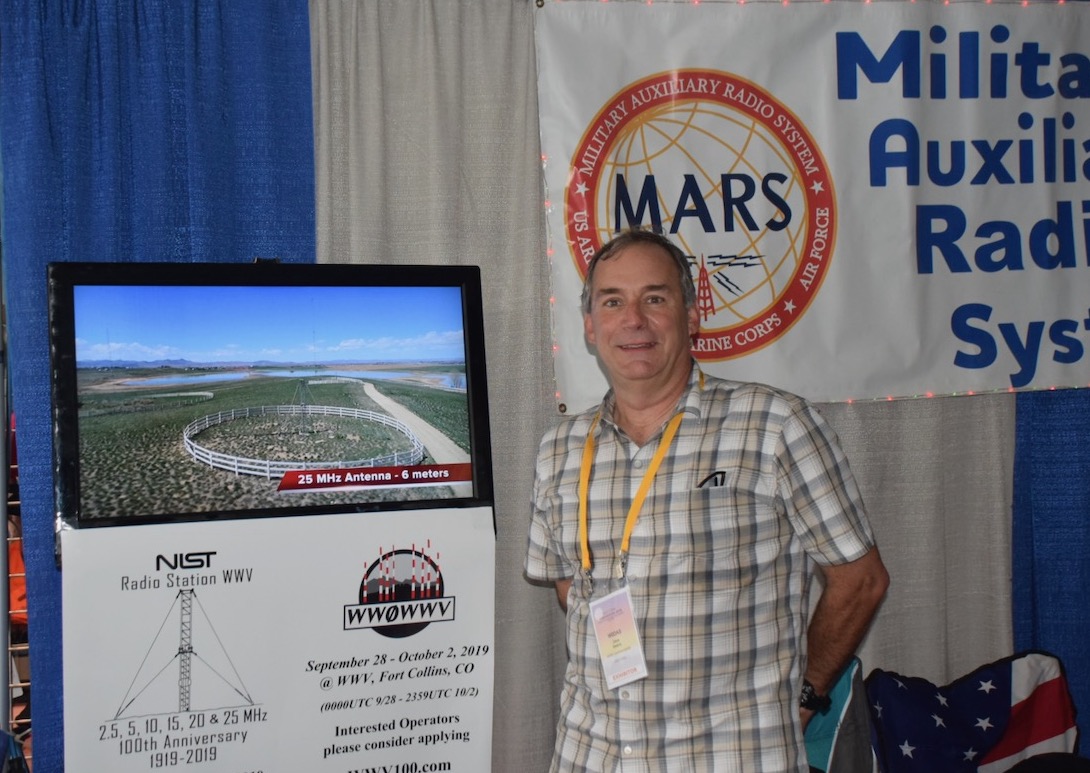
David Kazdan, AD8Y, EE Professor at Case Western in Cleveland, OH, got in touch with the Committee and Dave via Matt at WWV soon after the event was announced in the spring. David suggested the Festival of Frequency Measurement run concurrent with the WWV 100th. In the end, a unique, unassigned “Special” station was created to carry out NIST traceable frequency measurements, make school and museum contacts, and coordinate the Festival of Frequency Measurement. Case Amateur Radio Club came in force and manned the Special station operations.
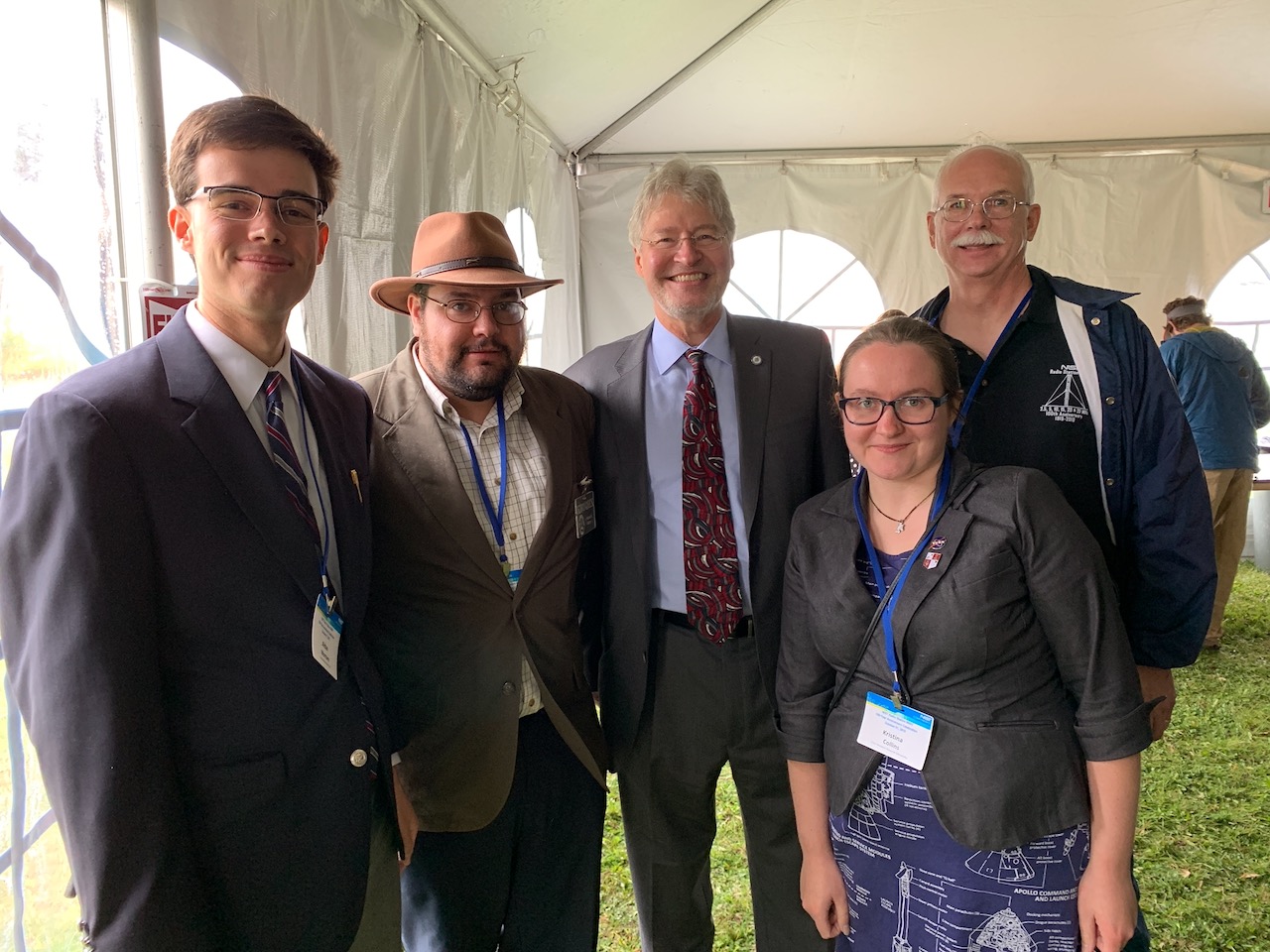
As word got out, interest in participating grew, and before you knew it, there were 100 operator volunteers. The difficult task of building an operator schedule was accomplished by Eric Tamme, KKØECT, by the end of June, throughout the summer, and up to the start of the event. Eric was also instrumental in operations and is one heck of a sharp CW operator.
Mark took charge of setting up operations, logistics for computer networking, all automated station logging, and upload to LOTW and OQRS in nearly real time. Mark also wrote a program for tracking and displaying the real-time activity of the various bands, operators, and statistics. Mark kept us all focused and moving forward and was a core member of the Committee.
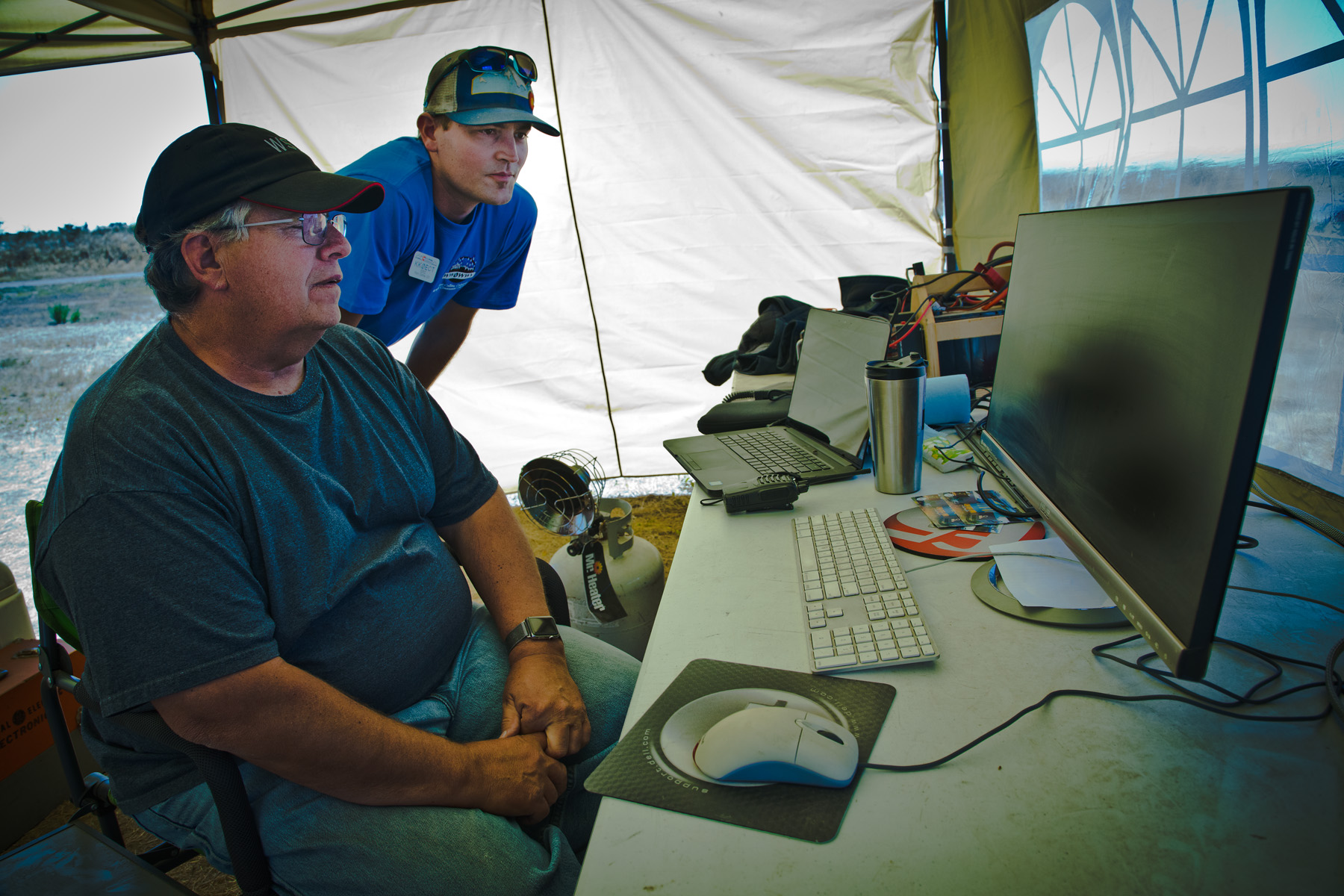
Darren Kalmbach, KCØZIE was the site manager and coordinator, established the campsite for operations, coordinated with WWV staff, and ran the camp logistics for over a week, with hardly a break. Darren also handled treasurer duties, he is the NCARC treasurer as well, and a NCARC Board member.
James Cizek, KIØKN was technical support for operations and linked the SES site via microwave to the NCARC repeater site on Horsetooth Mtn for a 30Mb/s wireless network in camp. James troubleshooted numerous issues during the week of operations, is the Technical Advisor to NCARC, and also is a NCARC board member.
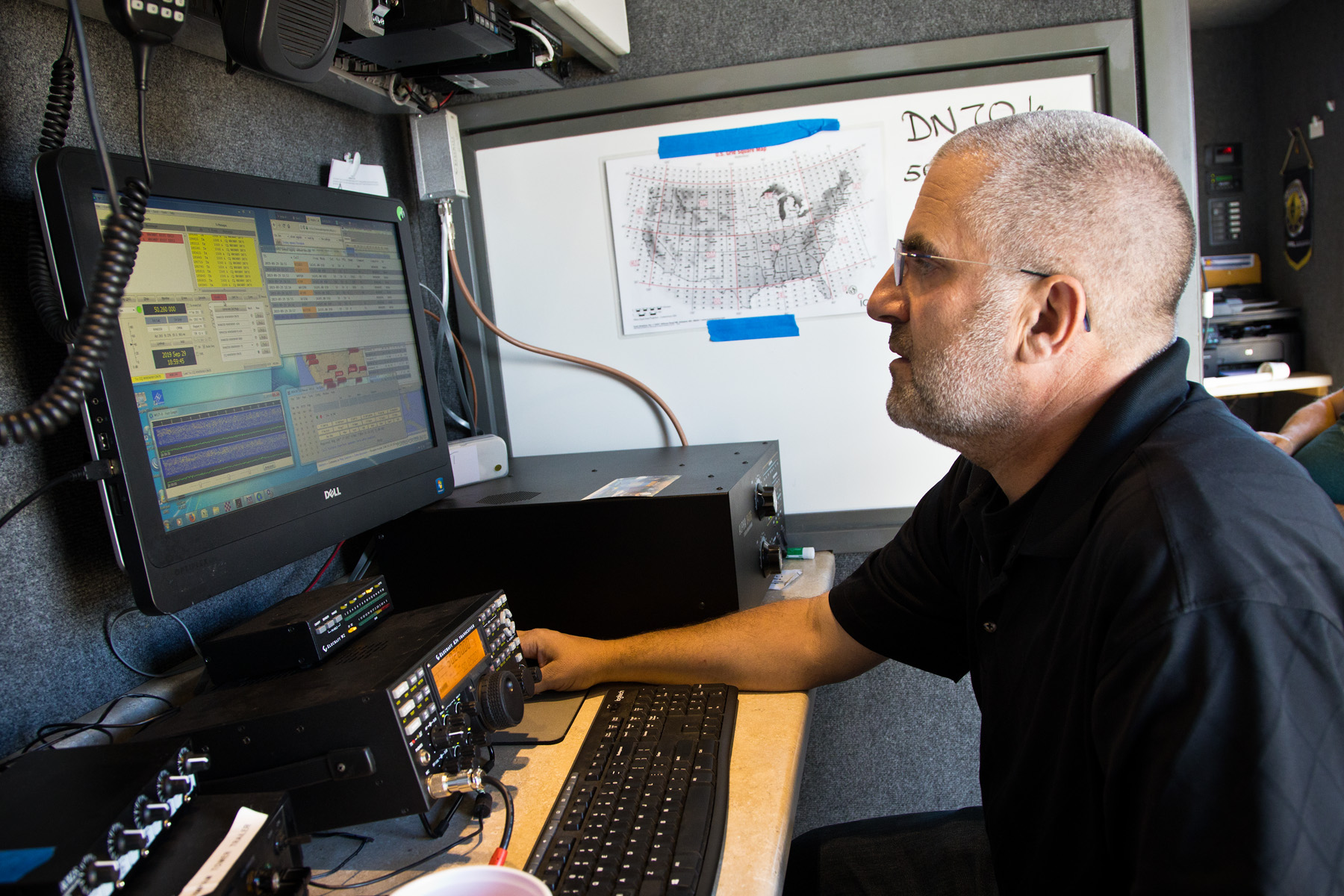
Doug Sharp, K2AD, of RMHAM joined in planning mid-summer 2019, and brought substantial equipment and logistical support in the way of the RMHAM Communications Trailer, a 50-ft telescoping tower, a 15kW diesel generator, and more, as well as his technical know-how and experience. RMHAM support was vital to the success of the event.
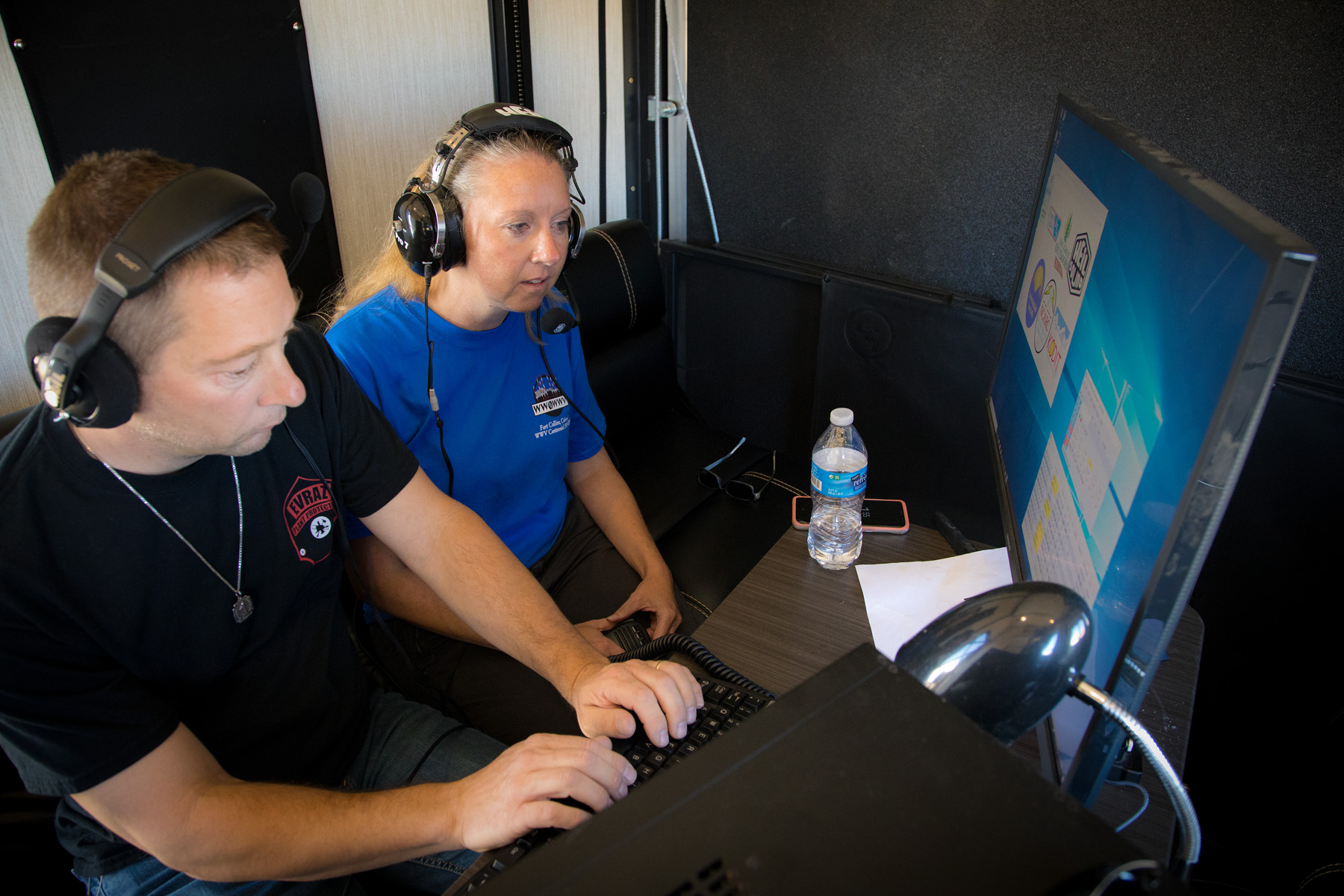
Amanda Alden of Ham Nation, K1DDN, helped immensely with publicity, getting the event covered on two shows in the summer, and coaching Dave on social media (the one area the event was weak). She was a great supporter of the event, and she and husband Jeff Carrier, K0JSC, were able to attend the event and operate as well.
Ham Talk Live!, hosted by Neil Rapp, WB9VPG, hosted two programs with Dave and Matt Deutch in June 2019 and then just weeks before the event in September 2019.
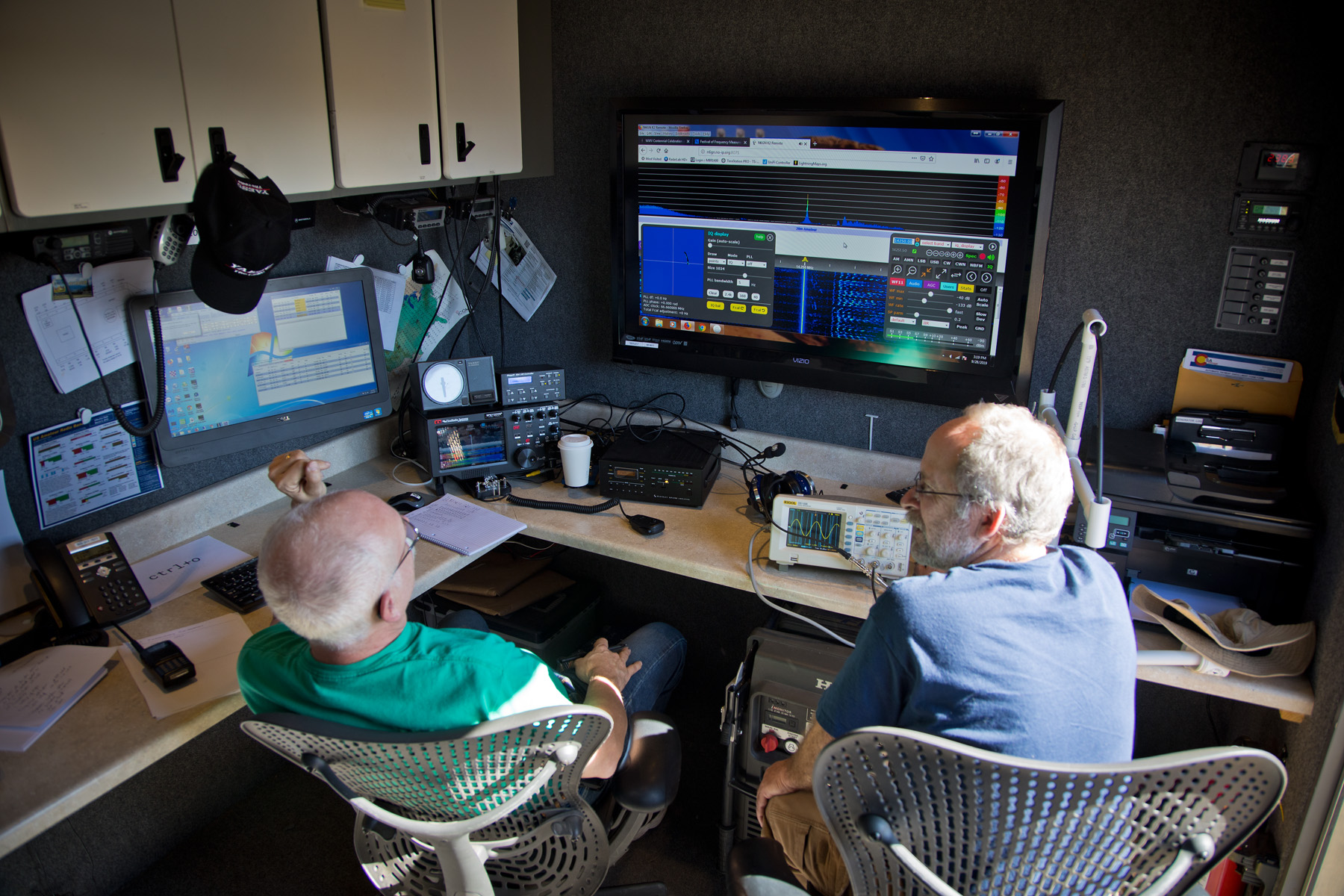
Greg Ella, NØEMP, helped provide technical support and configuration of equipment for the Festival of Frequency Measurement and ongoing support for just about anything that came along. Greg is the at-large NCARC Board member.
In late summer, Dave Winnett, WØDDZ, NCARC Public Affairs Officer and Board member, connected the Committee with The Great Outdoors RV in Evans, CO, and they generously loaned the event two huge fifth wheel campers for the week to round out the needed operation space.
Bob Schmid, WA9FBO, helped raise funds through his associations with the Poudre Valley REA, the electrical supplier to the WWV and WWVB stations. He also helped coordinate volunteers for the set-up and tear-down of the site. Bob brought needed perspective and helped in asking the right questions at the right time.
Trial Run Weekend - August 2019
Because of the complexities of getting everything up and running for the 5-day event, the Committee decided to run a trial set-up the weekend of August 24-25, 2019. Although the Flex and Elecraft radios would not arrive until close to the event, SteppIR delivered the loaner antennas in time for the trial. David Kazdan, AD8Y, and his wife Laura Gooch, N8NFE, flew in via private plane from Cleveland, and joined the Committee and other local hams.
David Kazdan, AD8Y, assists with coax as one of the 2-element SteppIR beams is prepared to be lifted, August 24, 2019.
One of the two element SteppIR 20-6m beams was assembled and tested on the RMHAM tower trailer. The trailer was used during the 100th event for the 6m stacked array. Adjustable SteppIR verticals were also tested, but the team decided fixed verticals for 80m and 40m would be better. The microwave networking was tested from the site which helped identify potential knife edging at 3GHz. The trial run was an important opportunity to shake out some bugs and get a better feel for the site and how operations would be accomplished.
The WWV 100th Anniversary begins – September 25 – October 2, 2019
Wednesday, September 25 was the start of camp assembly, with the positioning of the 5th wheel Toy Hauler RVs (very nice!), the arrival of the camp sanitation Port-a Johns, and arrival of the generator, RMHAM Comm trailer, telescoping 50’ mast van, 25’ tower trailer, and crank up 50’ tower for the three beams. Camp Central was established, and equipment deployed.
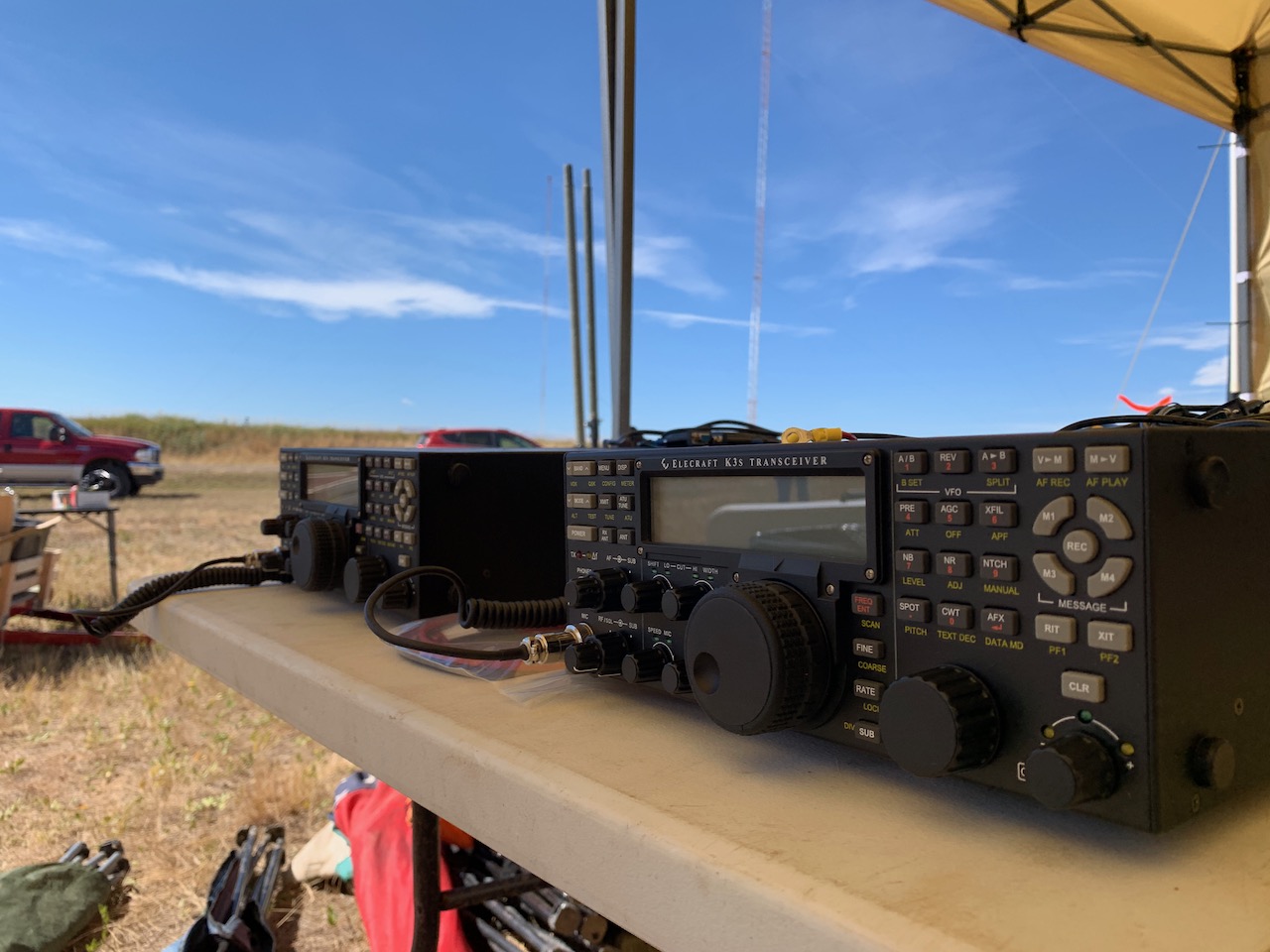
Thursday, September 26 saw the completion of the verticals and beams as well as the entire computer network and all radios installed and troubleshooted. The goal was to have the station completed 24 hours before operations were to start, and we accomplished that for the most part.
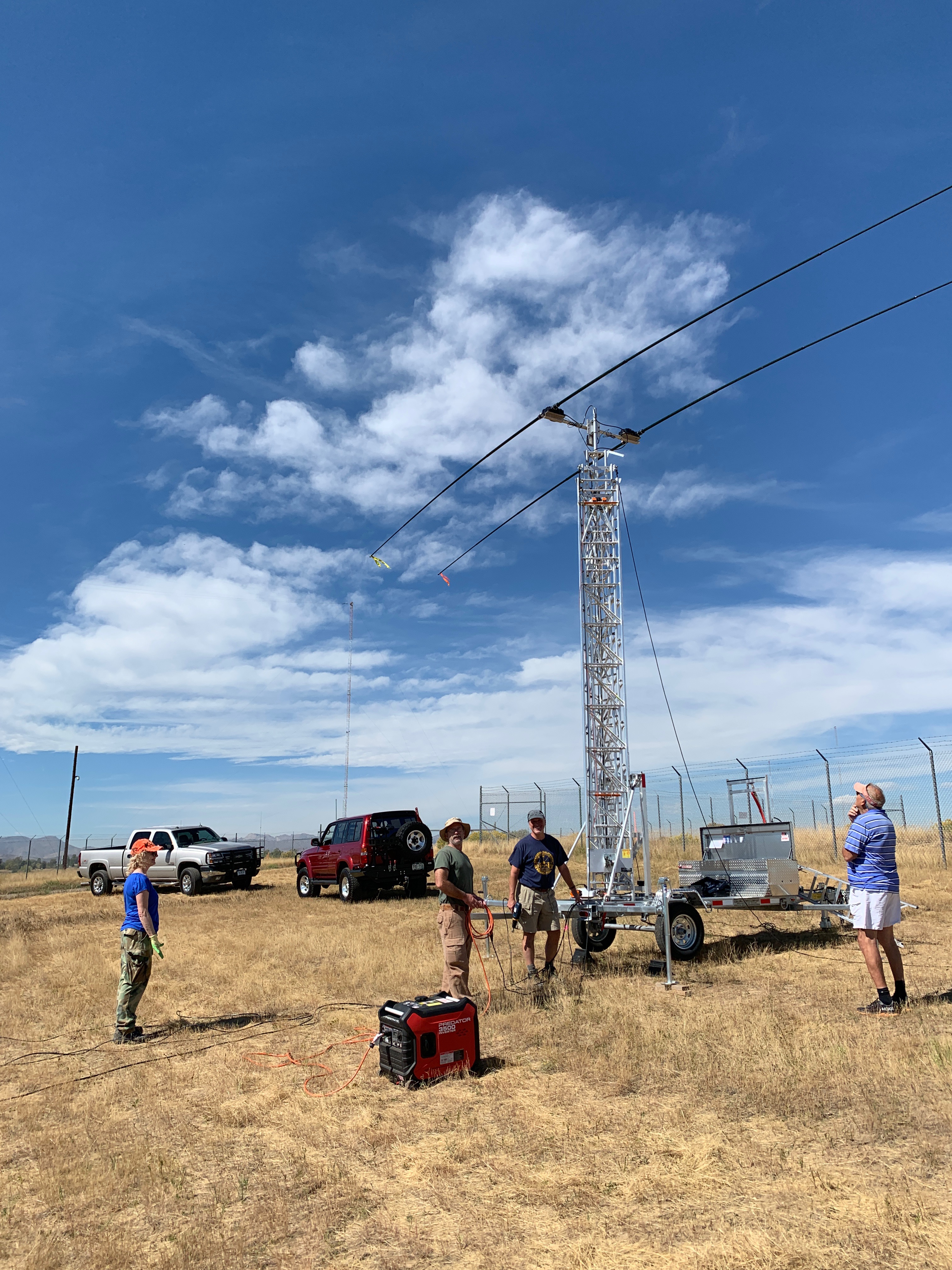
We also learned that Thursday that some miscommunication between NIST Boulder and Gaitherburg had occurred, and that camping on NIST property was prohibited. We continued on unabated and figured that 24-hour on-site supervision was required for 24-hour SES operations, and that would be our explanation for what some might mistake as camping. Operators did not camp on site, although some working the night shifts may have slept a wink or two in their cars. Fort Collins is just 8 miles to the south, and Wellington about 6 miles to the northeast, with motels/hotels and some camping in the area.
With the hard work put in on the previous two days, Friday, September 27, was a chance to work out the kinks, play radio, visit with numerous hams, and start tours of WWV and WWVB. All operators were given tours of the WWV and WWVB radio station by the station staff, who conducted several hours-long tours multiple times over the 5-day SES operation. What a great opportunity to see the HF transmitters for WWV, and the massive transmitters, antennas, and tuning systems of WWVB. Having direct access to the operators and their experiences made the tour very personal, and a highlight for many of the visiting amateur operators.
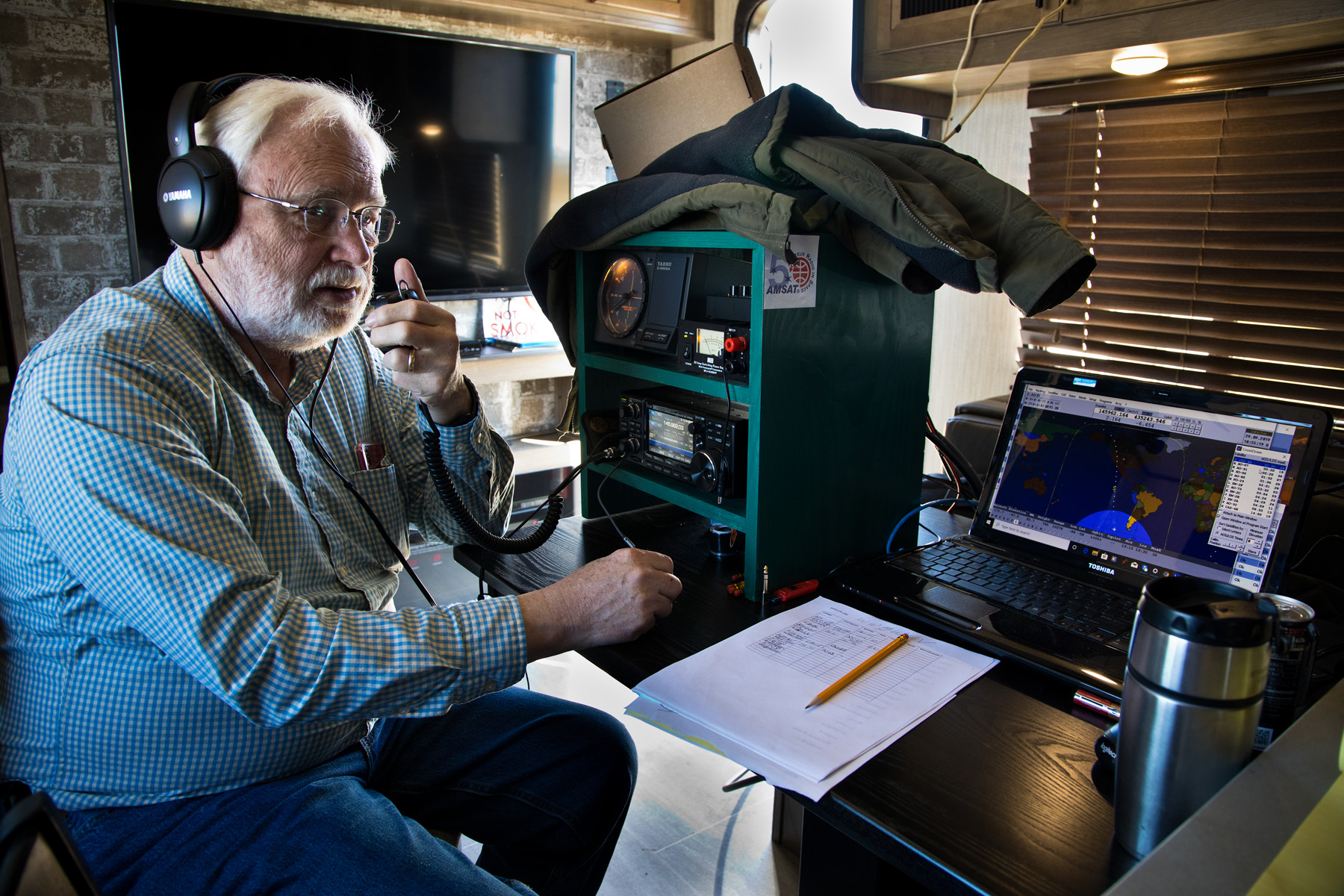
With 10 months of hard work behind the Committee, Amateur Radio Special Event Station WWØWWV went on the air at 6pm MDST September 27; 0000UTC September 28, 2019. There were 7 stations on the air; 20m and 160m, 80m and 15m, 40m, 30m, 6m, satellite, and the Special multiband station. 2m and 70cm were also conducted from mobile vehicles and handheld yagis. Conditions were not favorable with the solar activity at a minimum, and night communications stymied. But over the 5 days there were 10,600 QSOs logged, breaking our goal of 10k.
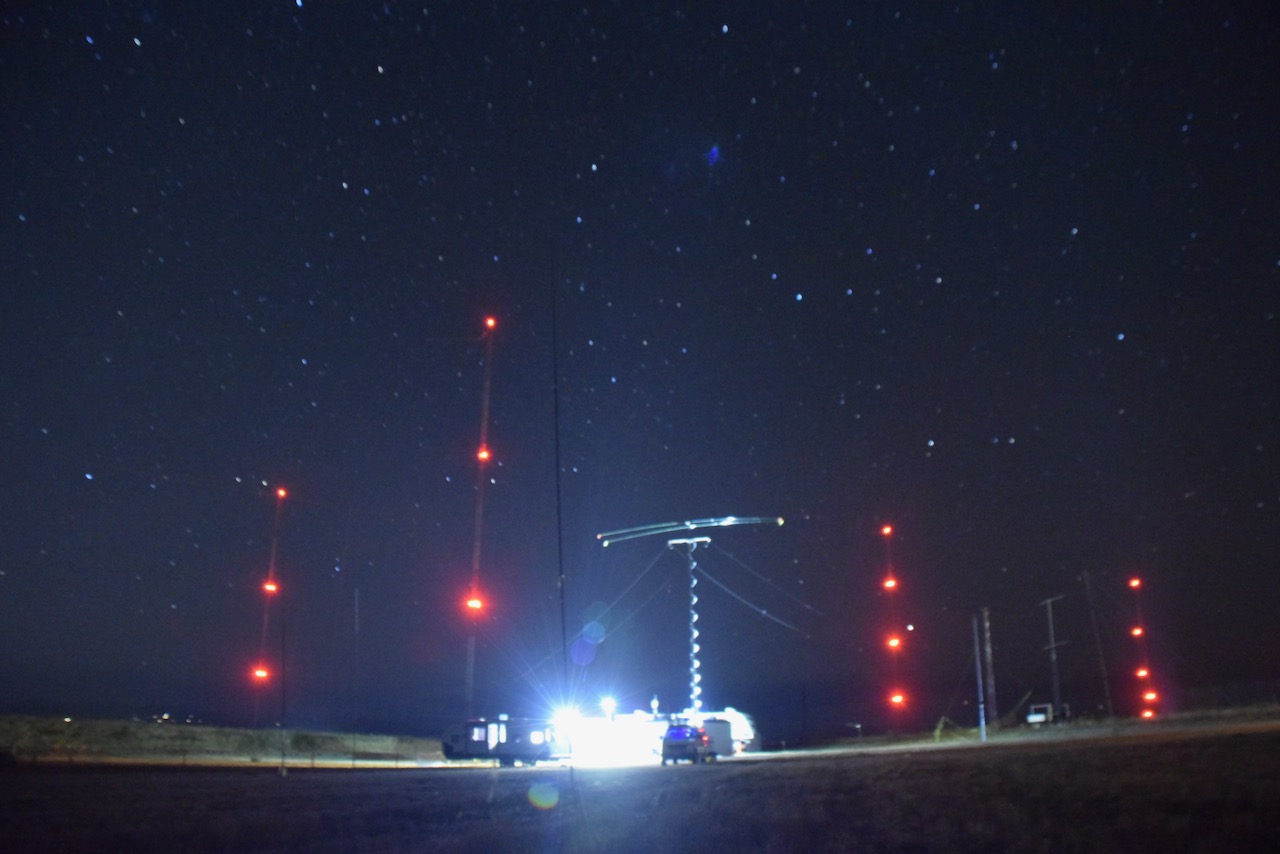
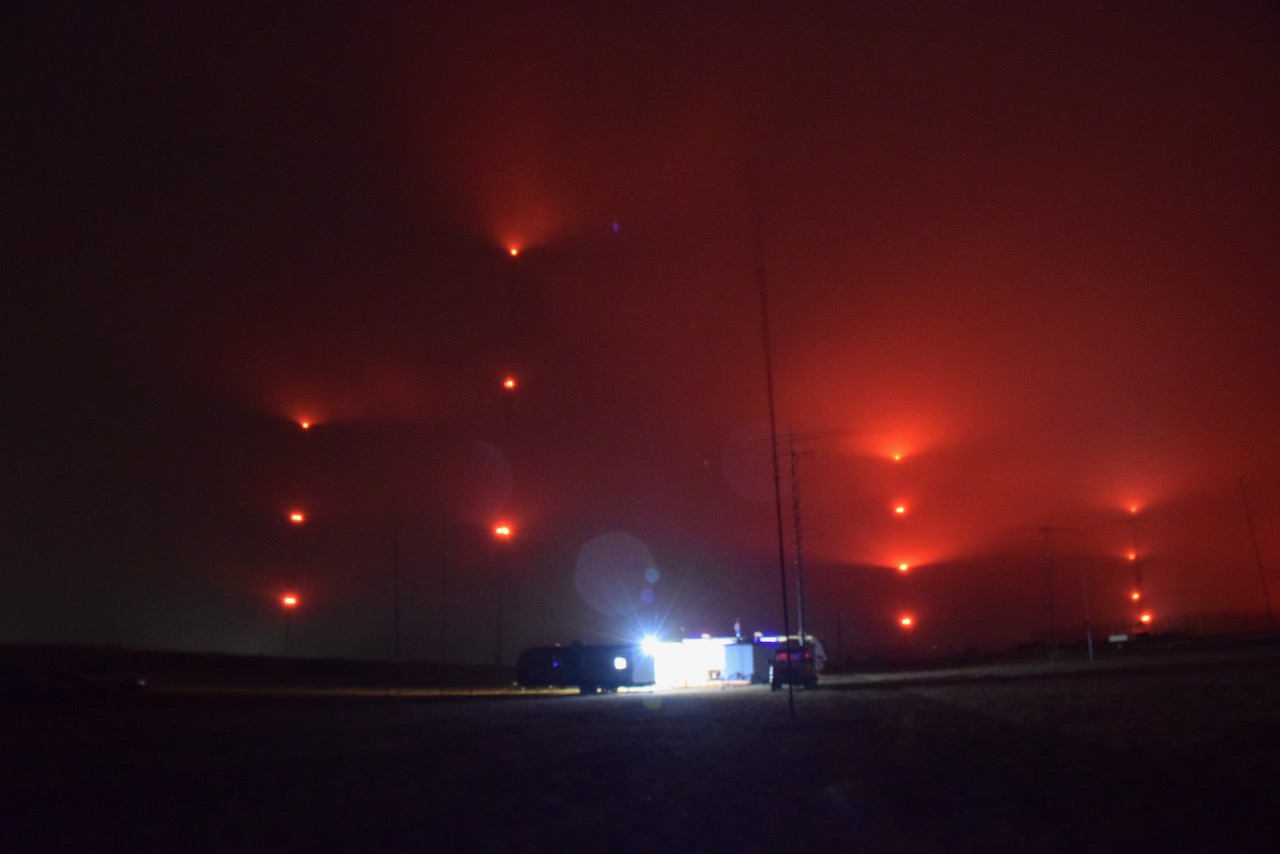
Besides HF, operations on both FM and SSB satellite were conducted, as well as 6m meteor scatter. The Special station was used for the Festival of Frequency Measurement, scheduled school and university contacts, as well as communications to the local Fort Collins Museum of Discovery.
Phil Burk, KØPRB, and Luann Barnes, KØLAO, set up their “StarDrive” mobile astronomy and ham radio rig, and the Museum of Discovery promoted the event by publishing their own unique QSL card handed out to patrons. Kids had a chance to talk on the air, the youngest just 2!
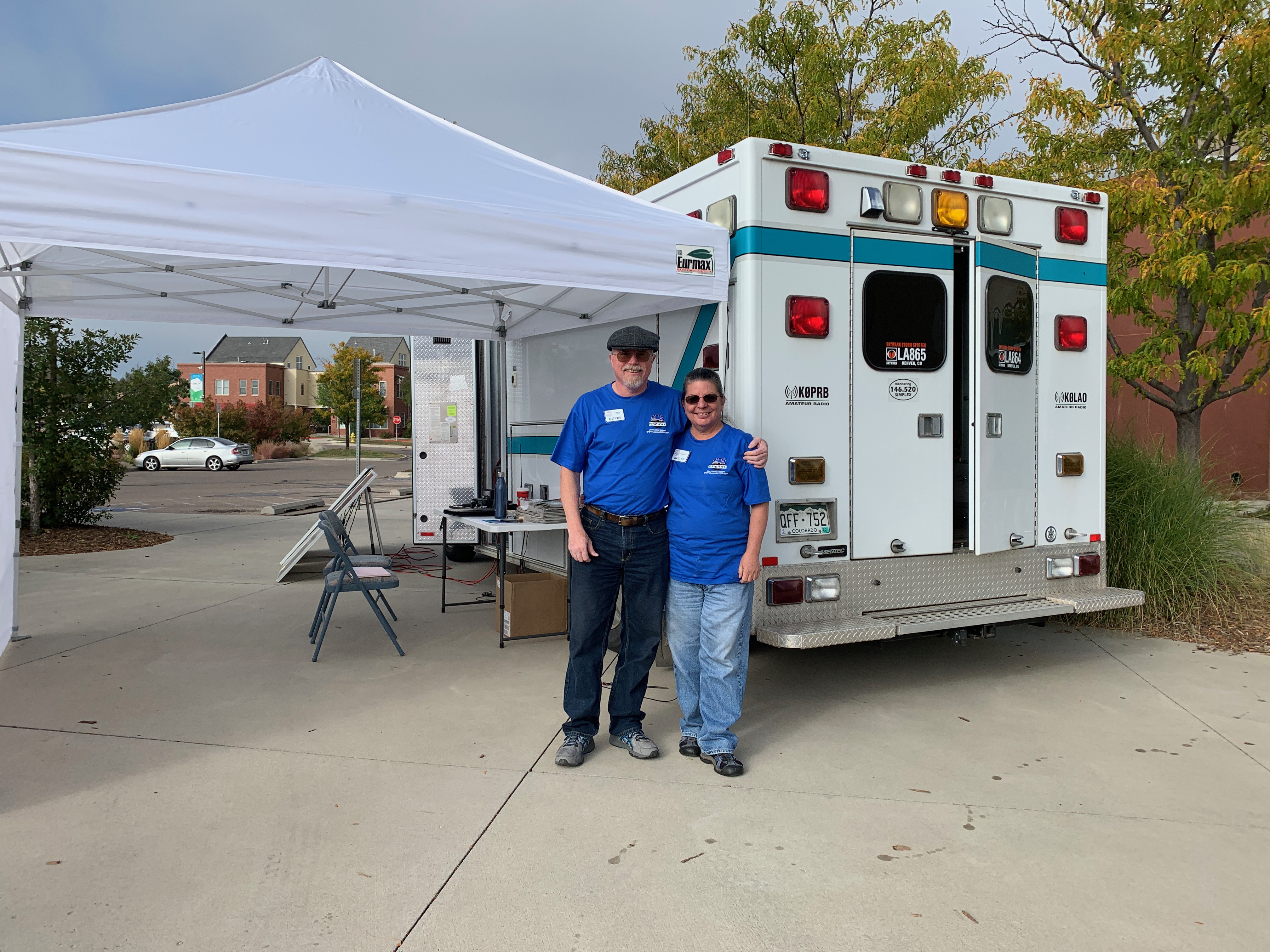
October 1, 1919 – October 1, 2019
The Colorado weather didn’t disappoint during the 5 days and varied from warm and clear blue skies and starry nights, to foggy mornings, and of course a constant rain on October 1 for the official 100th anniversary ceremony. Dr. Walter Copan, NIST Director, had made plans to attend, so security was heightened, and the NIST police and other security present all day. About 100 guests from NIST Boulder, NIST Gaithersburg, and a number of amateurs attended the event held in a large tent, complete with a birthday cake and a historic talk by Glenn Nelson, AEØGF, Dr. Phil Erickson, W1PJE, representing HamSci, and Dr. Walter Copan.
Kevin Utter, N7GES and a member of the WWV Committee, was asked by NIST to record a couple of announcements that were broadcast on WWV and WWVH. The first announcement ran the day of the 100th anniversary, soliciting reception reports for a special commemorative QSL card. The second ran for three weeks prior to the event during the MARS hourly timeslot announcing the SES. What an honor for Kevin to use his vocal talents on such an important occasion, and he may be the first amateur to record an announcement like this for NIST.
FUTURE LINK TO AUDIO FILE HERE. Thank you for your patience.
Caption for the missing audio link: Over air audio recording of Kevin Utter, N7GES, from October 1, 2019, announcing both the 100th anniversary of WWV and the WW0WWV SES. The SES announcement ran for three weeks prior to the event in the MARS timeslot on WWV and WWVH.
The Goddard Amateur Radio Club joined in the celebration as well, operating SES W3V during much of the same period, and we even managed a QSO during the busy week. The NASA Goddard Space Flight Center Visitor's Center is built in the building WWV occupied prior to moving to Colorado in 1966. They held a simultaneous celebration and using cell phone video from Colorado projected the ceremony in the Visitor's Center auditorium for the NASA staff.
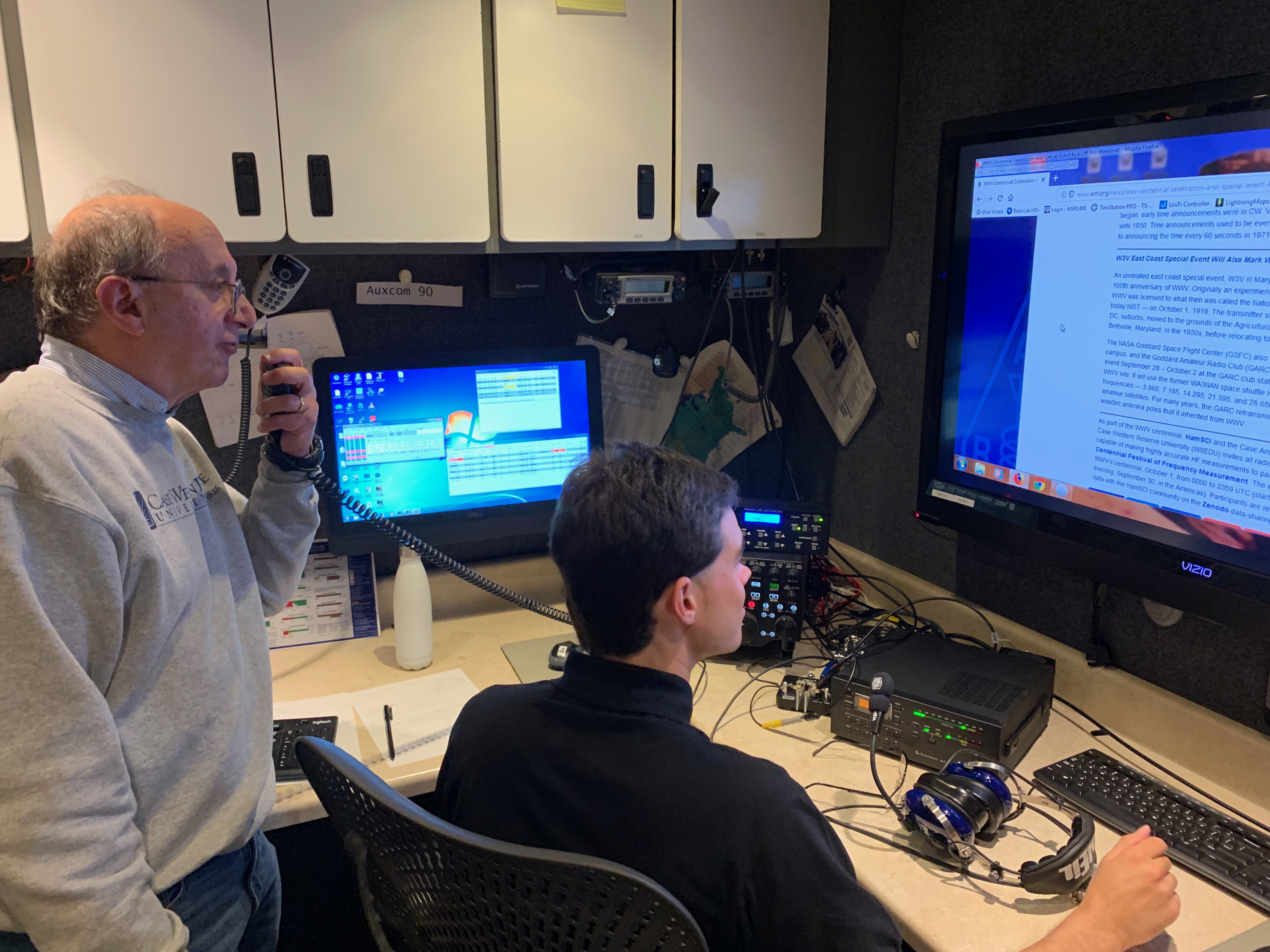
After the official hoopla and tours of WWV completed, the WWØWWV Special Event Station had a visit from Dr. Liz Donaly, NIST Time and Frequency Division chief and Dr. Walter Copan, NIST Director. They toured through the soggy camp, visited the various operators on air at the time, and were impressed by the amateur community’s efforts.
All good things come to an end . . .
Wednesday, October 2, saw our 5-day operations coming to a close at 6pm that evening. Earlier in the day, we broke the 10,000 QSO mark. We finally had a chance to look back at the week and realize what we had accomplished over the last 10 months, and all of us were happy and proud of the job we’d done. We started breakdown shortly after 6, and completed the next day and had the site cleared by late afternoon October 3.
QSL cards
It took a few weeks to get images from various amateurs and attendees of the event together in a QSL card, and after production we tackled responding to the hundreds of surface mail as well as OQRS requests. The initial mass production was done by 5 people working for 4 hours, stamping, labelling, authenticating, and finally mailing over 500 requests. Since that original mailing, an additional 500 requests have trickled in.
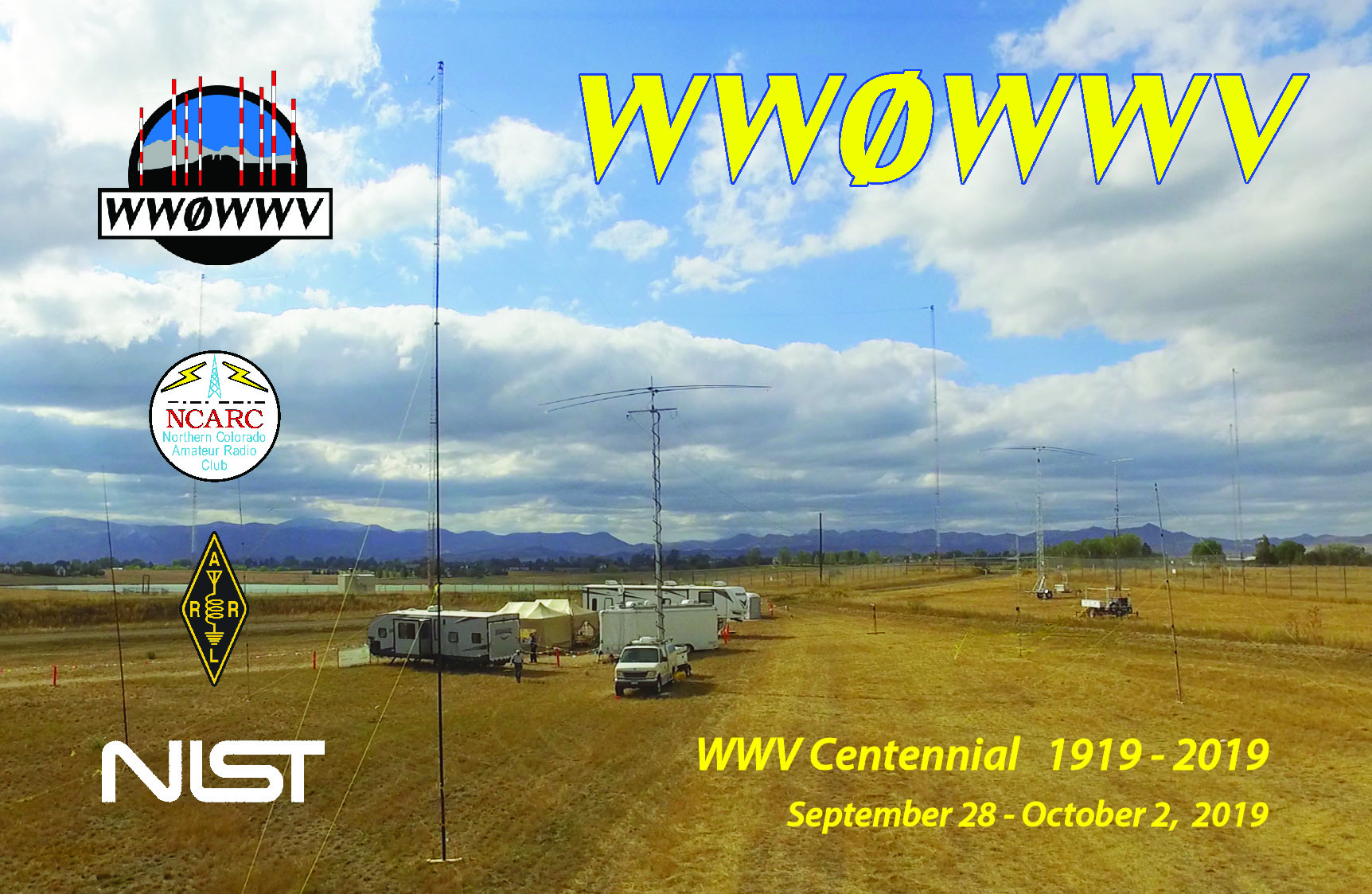
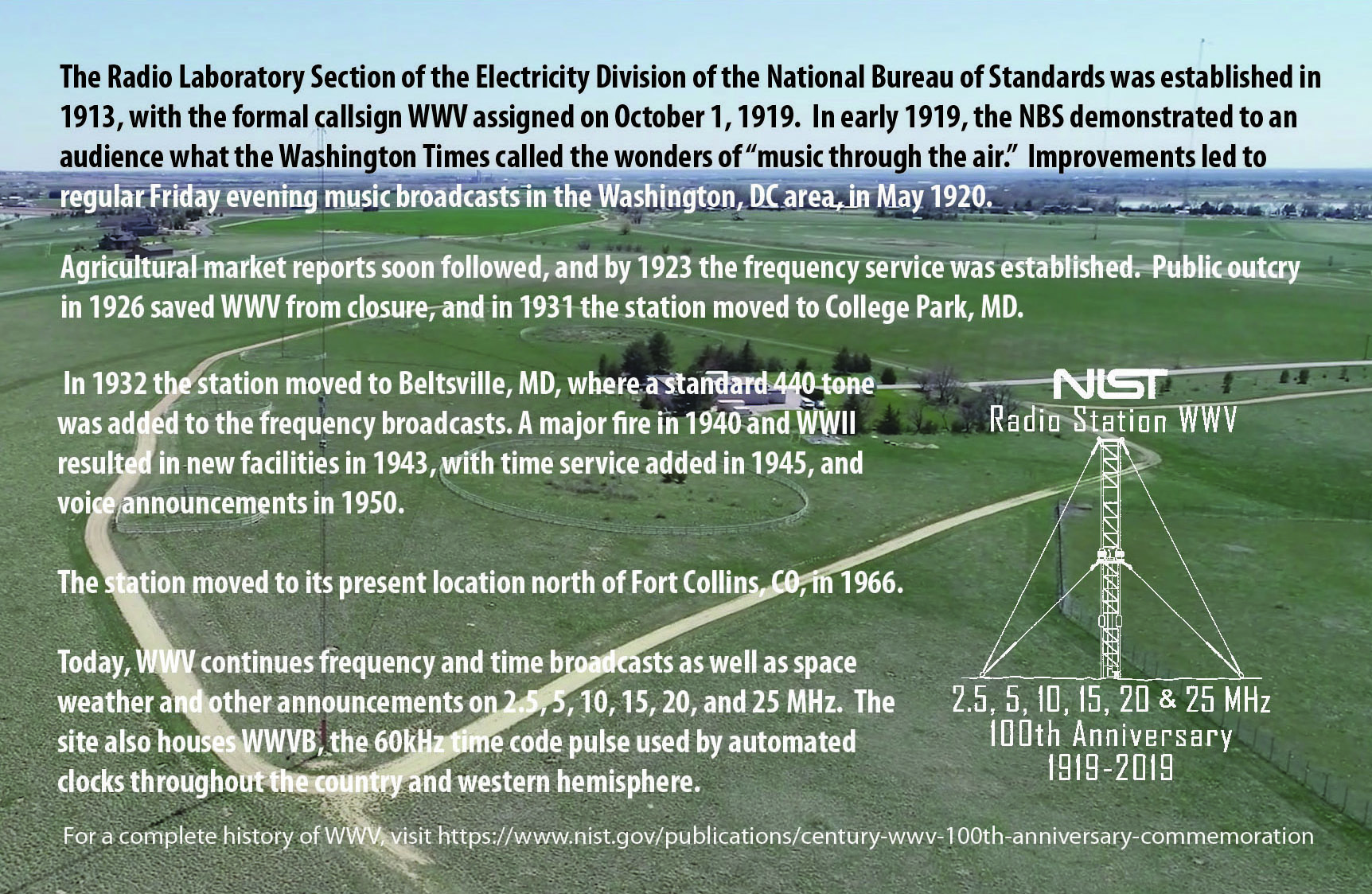
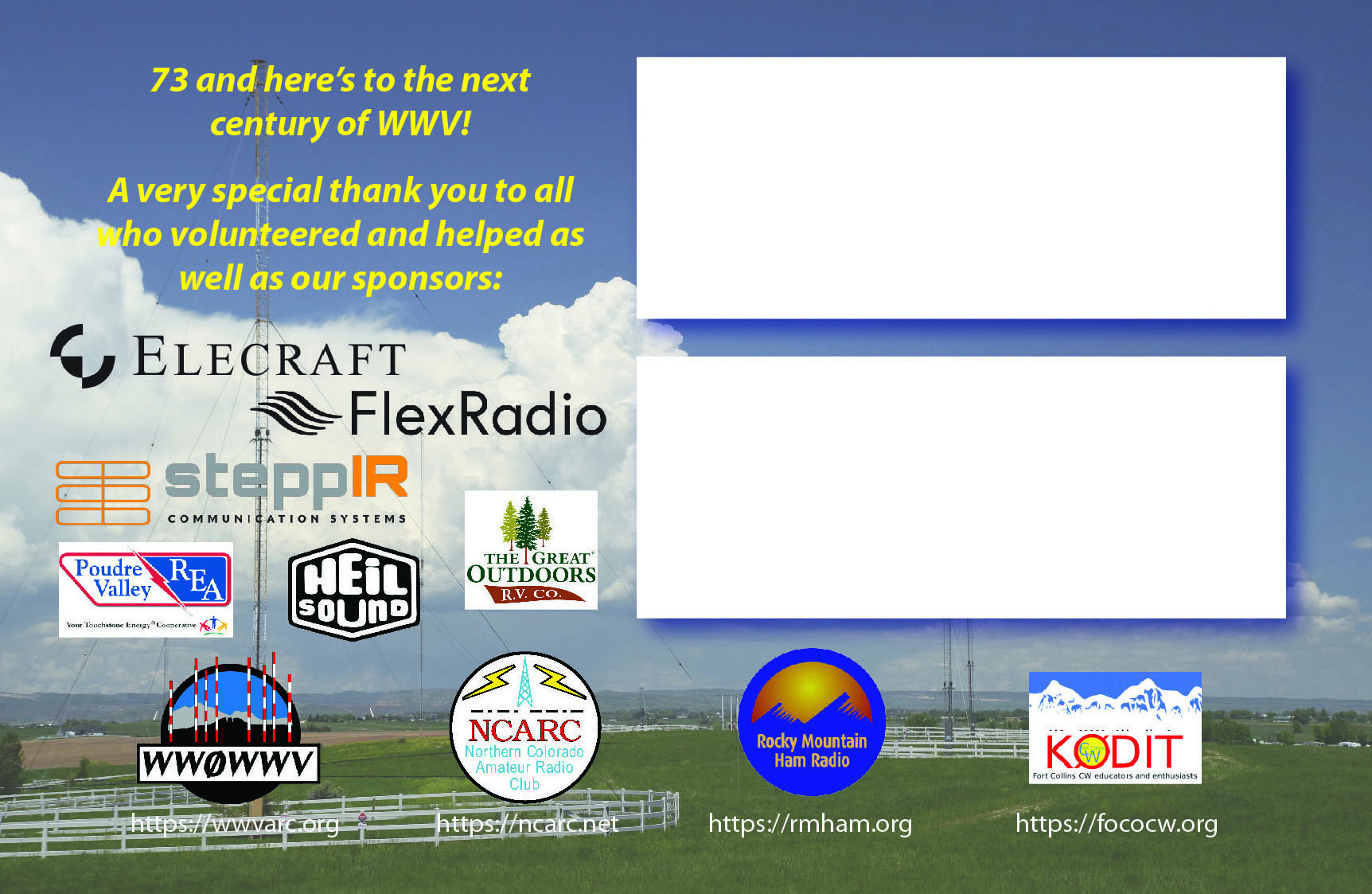
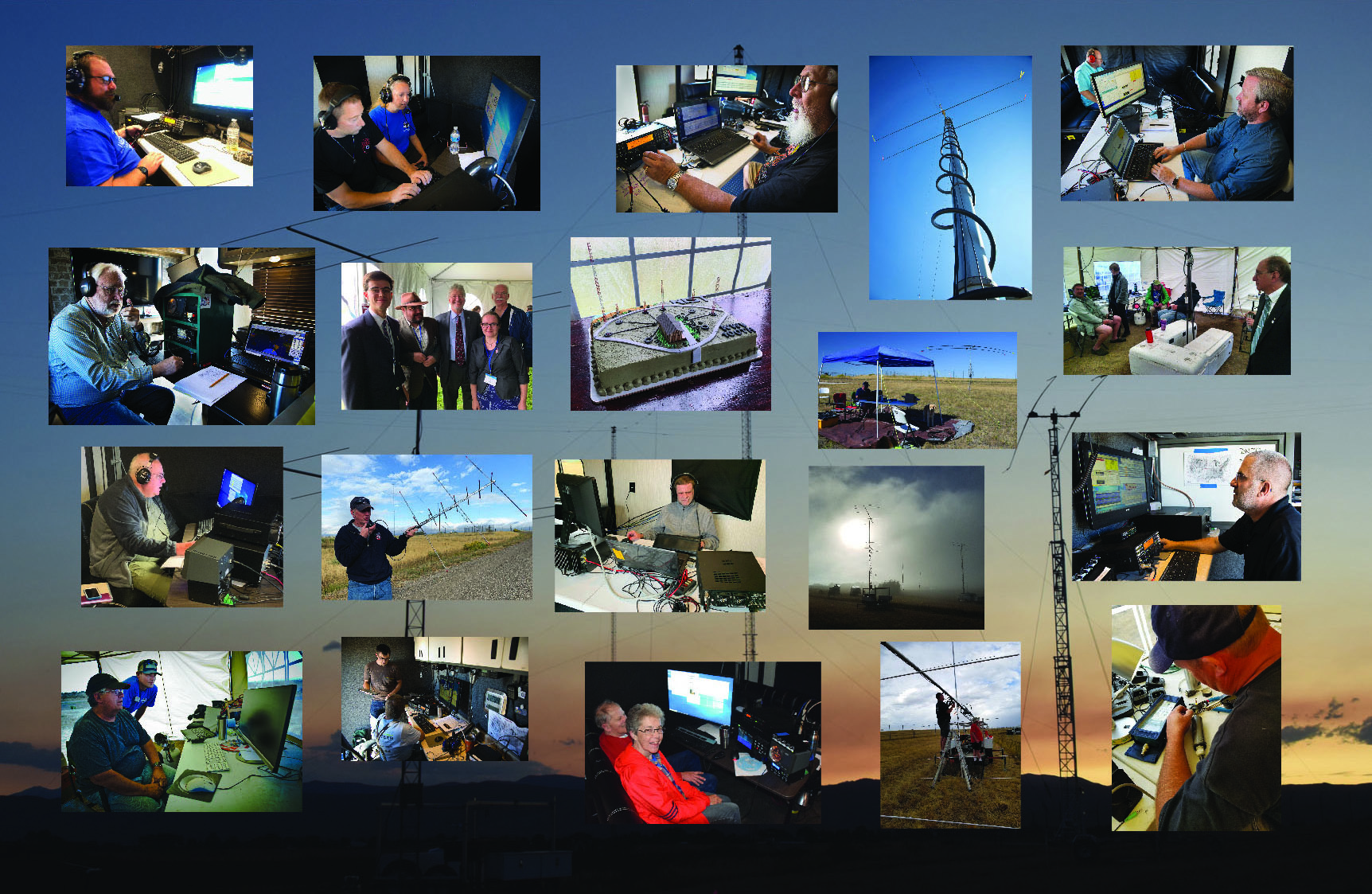
In retrospect
The WWV 100th Anniversary production was a tremendous amount of work. We had our challenging and difficult moments, but looking back at all involved, the Colorado and broader Amateur Radio community came together to produce a class special event station, one that would be difficult to duplicate. There were no issues, no serious injuries, no lost equipment. Everyone had a tremendous time and the best of memories.
Now, after more than a year of COVID, we realize how lucky we were to pull off this kind of event. Our hope is that we can one day return to WWV, set up a SES, and share this unique part of radio history and science with the amateur community another time.
73 !
